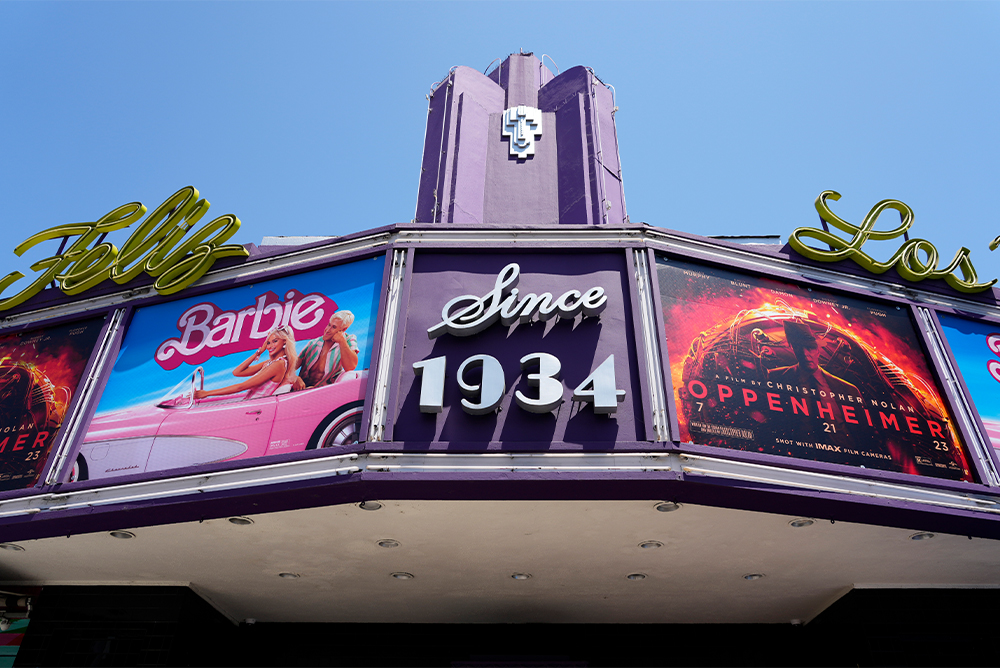
The two competing blockbusters of the summer aren’t just entertaining films about a physicist and a doll. Columnist Joe Mathews argues they should also be viewed as apocalyptic documents. Courtesy of AP Newsroom.
Which region is the greater threat to humanity: Northern California or Southern California?
That’s the most urgent question raised by 2023’s great cinematic contest between Oppenheimer and Barbie.
Sure, these are entertaining films about a physicist and a doll. But both movies are also, in no small part, California-based stories about global nightmares, about the Earth-altering threat of bombs and bombshells alike.
Embedded in those nightmares are warnings about the damage that Northern and Southern California can do when we send our ideas out into the world.
Oppenheimer is the Northern California nightmare. While much of Christopher Nolan’s film takes place in New Mexico, where the first atomic bombs were built, the most important moments occur at Berkeley, where J. Robert Oppenheimer was a professor from 1929 to 1943.
It’s there that he meets the Manhattan Project’s military chief, Leslie Groves, and befriends the physicist Ernest Lawrence (the Lawrence of the Bay Area’s Lawrence Livermore National Lab), who becomes a crucial collaborator in the Manhattan Project. In fact, the lab in New Mexico that produced the nuclear bombs ended up being managed by the University of California.
The whole endeavor is a quintessential Bay Area enterprise. Very smart people from around the world come together to rapidly create a disruptive technology, without fully appreciating its perils and complications until it’s too late. Oppenheimer has prompted comparisons to how Silicon Valley is now making available artificial intelligence tools available without understanding their consequences.
Among the nuclear age’s cultural and commercial products was Barbie (born in 1959). She, and the new film about her, are Los Angeles nightmares.
The director, Greta Gerwig, is a Sacramento kid who shares her home city’s loathing of all things L.A. So, her film pins most of the damage that Barbie has done on Southern California, where she was invented and manufactured.
Barbie, like Los Angeles itself, is a sun-splashed comedy with a dark noir heart. The central joke of the film is that when Barbie, in unexpected existential crisis, leaves the seeming perfection of Barbieland for “Reality,” it turns out to be L.A. Amid the city’s most unreal Westside precincts (especially Venice), Barbie learns of the impossible expectations her example places on women.
Barbie’s would-be boyfriend Ken, who is confined to hanging around the beach in Barbieland, discovers the possibilities of patriarchy after he falls in love with the phallic glass office towers of Century City. And when Ken takes those supposed Southern California values back to Barbieland, that utopia of feminism (with a set design that resembles Palm Springs) collapses. Soon, the various Ken dolls have imposed a bizarro dictatorship of men, who subjugate the various Barbies, who’d previously served as president and controlled the Supreme Court.
It might be wrong to think too hard about a movie as addled and antic as Barbie, but the film does reflect the Hollywood work realities of the women who made the movie. Gerwig, star-producer Margot Robbie, and their colleagues have had to navigate an entertainment industry dominated by dim-witted Kens. (The rest of L.A., thank goodness, is a bit more egalitarian, as Mayor Karen Bass and the all-female Los Angeles County Board of Supervisors can tell you.)
Both films, however, feel more than a little soulless. Barbie, for all its righteous feminism, is a corporate vehicle for selling dolls. It misses opportunities to make light of the cynicism of this American moment, when corporations try to talk like social movements, and social movements often behave like corporations. The anxieties of Barbie are firmly upper-middle-class and higher; none of the women or men of the film worry about what worries most Angelenos—scratching out a living in a too-expensive place.
Oppenheimer is even more callous. It’s a film about nuclear weapons that doesn’t show their victims. We never see the human horror of Hiroshima and Nagasaki (which is why the film can’t get screened in Japan), or the damage people endured because of their proximity to the testing of such weapons, from the South Pacific to Central Asia.
This distance from real-life human concerns is what makes both films so unsettling—and so convincing as apocalyptic documents.
Together, they offer a two-part scenario for the end of humanity. First, we grow divided and isolated from each other because of the unattainable lifestyles and cultural expectations that Southern California creates and promotes. Second, we kill ourselves with the technologies masterminded by Northern California.




Send A Letter To the Editors